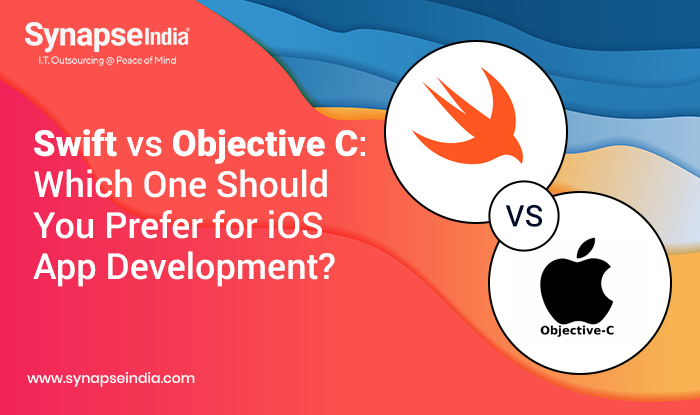 30 Jan 2024
30 Jan 2024
In the world of Apple's development ecosystem, swift vs Objective C stands out as the primary programming language, each offering its own set of strengths and characteristics. Objective-C, with a longer history, has been the traditional language for Apple platform development, while Swift, introduced in 2014, represents a more modern and expressive alternative. This detailed comparison delves into aspects such as syntax, performance, safety, interoperability, and community support, aiming to provide insights into the considerations developers face when choosing between Swift and Objective-C for iOS and macOS app development.

WordPress CMS is a versatile content management system (CMS) that offers a wide range of features to help users create, manage, and customize websites. Here are potential features of WordPress development:
Swift features a clean and concise syntax that is designed to be easy to read and write. It incorporates modern programming language concepts, making code more expressive and maintainable.
Swift is statically typed, which means that the data types of variables are known at compile time. This enhances code safety by catching errors during development rather than at runtime.
Swift for app development uses automatic Reference Counting (ARC) to manage memory. ARC automatically tracks and manages the memory usage of objects, reducing the likelihood of memory leaks.
Swift is designed to be fast and efficient. It has low-level memory access and is optimized for performance, making it competitive with Objective-C in terms of execution speed.
In 2015, Apple open-sourced swift for app development, allowing developers to contribute to its development and making it available on platforms beyond Apple's ecosystem.
Objective-C is a dynamically typed language, allowing flexibility in the type of data a variable can hold. However, this flexibility comes with the trade-off of potentially discovering type-related issues at runtime.
Objective-C uses message passing for method invocation, contributing to its dynamic nature. This allows for features like method swizzling, which can be powerful but requires careful use.
Objective-C is highly interoperable with C, allowing developers to use C and C++ libraries in their Objective-C code. This feature is useful for integrating legacy codebases.
Objective-C has been in use for a long time and has a mature ecosystem with extensive libraries, tools, and resources.
Before the introduction of Automatic Reference Counting (ARC), developers had to manage memory manually in Objective-C. While ARC is now the norm, developers may still encounter older codebases that use manual memory management.
Here is a detailed comparison that lets you choose between Swift and Objective C as your nextiPhone development language.
| Aspect | Swift | Objective-C |
|---|---|---|
| Syntax | Modern and concise syntax. | More verbose syntax, especially for method calls and error handling. |
| Type Safety | Statically typed, enhancing code safety. | Dynamically typed, providing more flexibility but potentially leading to runtime errors. |
| Memory Management | Uses Automatic Reference Counting (ARC) for memory management. | Historically used manual memory management; now supports ARC. |
| Performance | Designed for high performance and efficiency. | Competitive performance; mature and optimized for many years. |
| Options | Introduces options for safer handling of nil values. | Less explicit handling of nil values, leading to potential runtime crashes. |
| Interoperability | Interoperable with Objective-C code. | Fully interoperable with C and C++, allowing integration with legacy code. |
| Playgrounds | Includes Playgrounds for interactive and iterative development. | Does not have a built-in playground feature. |
| Community Support | Growing and active community; open-source nature fosters collaboration. | Large and mature community with extensive resources and support. |
| Open Source | Fully open source, allowing contributions from the community. | Closed source until recently, with some components open-sourced. |
| Popularity | Becoming increasingly popular; the default choice for new projects. | Established and widely used, especially in projects with a long history. |

Clearly outline your app development project requirements, including the platform (iOS, macOS, etc.), features needed, and any specific functionalities required.
Determine your budget for app development services. Different service providers may offer varied pricing structures, so understanding your budget constraints is crucial.
Look for reputable Swift and Objective-C service providers. You can find them through online searches, recommendations, or by exploring platforms like Clutch or Upwork.
Ensure that the service provider has experience in Swift and Objective-C app development. Check their portfolio for relevant projects, and inquire about their experience with similar apps.
Examine the provider's portfolio to see examples of their previous app development projects. Look for diversity in app types, complexity, and industries served.
Both Swift and Objective-C have a variety of frameworks that cater to different aspects of iOS and macOS app development. Below are some of the best and commonly used frameworks for Swift and Objective-C:
These frameworks provide a foundation for building robust and feature-rich iOS and macOS applications. The choice of frameworks depends on the specific requirements of your project and your preferred programming language (Swift or Objective-C).
Choosing between Swift and Objective-C depends on factors such as project requirements, team expertise, and the need for interoperability with existing code. For new projects, Swift is often recommended due to its modern features, safety, and growing community support. However, Objective-C remains a valuable iOS development language for certain scenarios, particularly when dealing with legacy systems or maintaining long-established applications. As of the current landscape, swift for app development is increasingly becoming the preferred language, but both Swift and Objective-C will likely coexist for the foreseeable future as iOS development languages.

